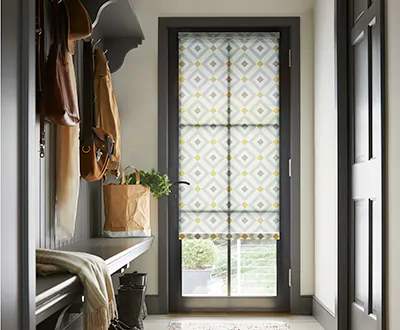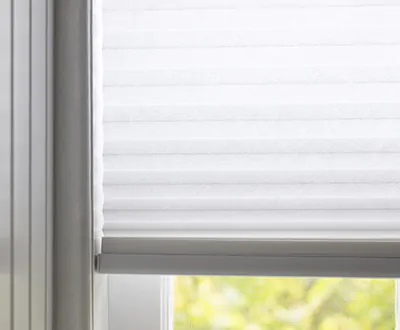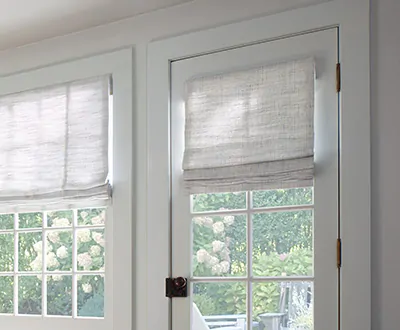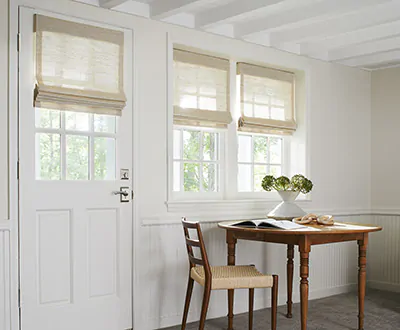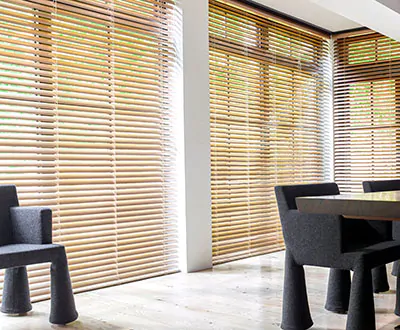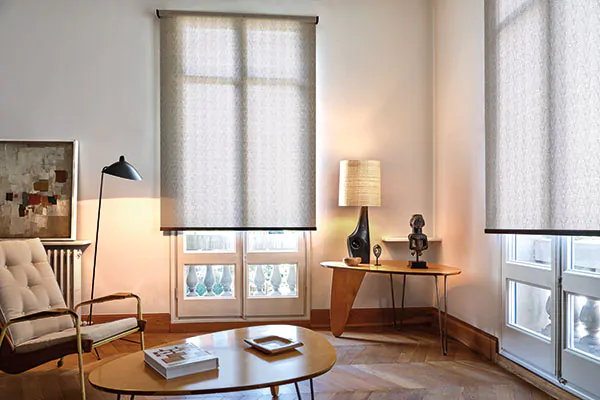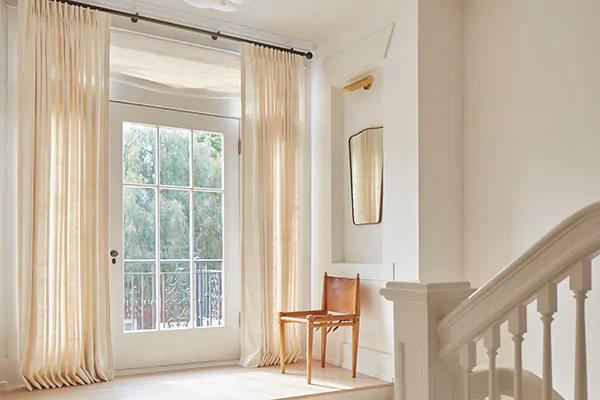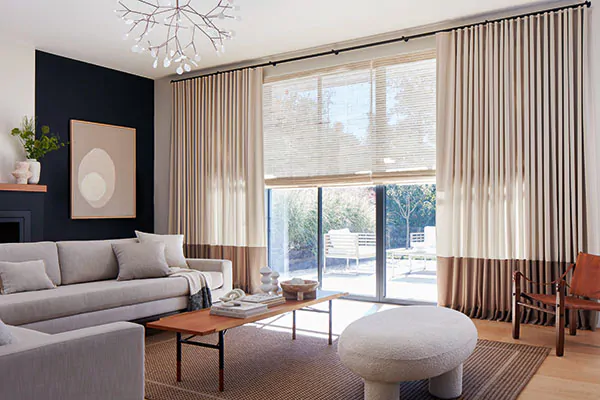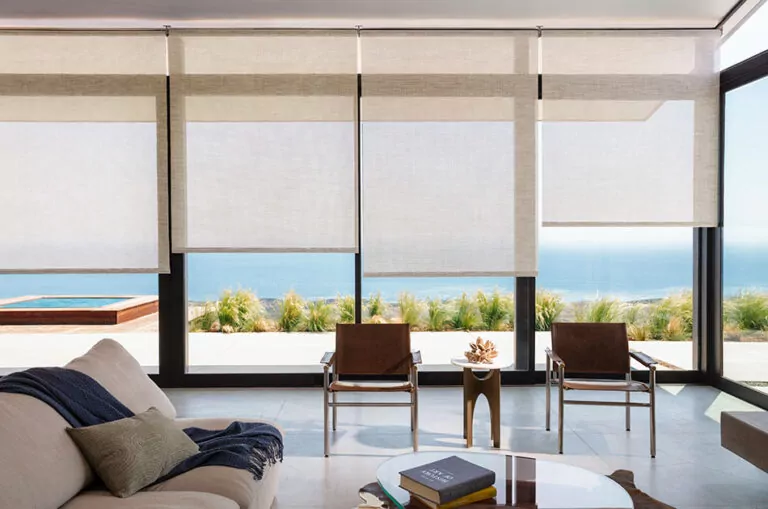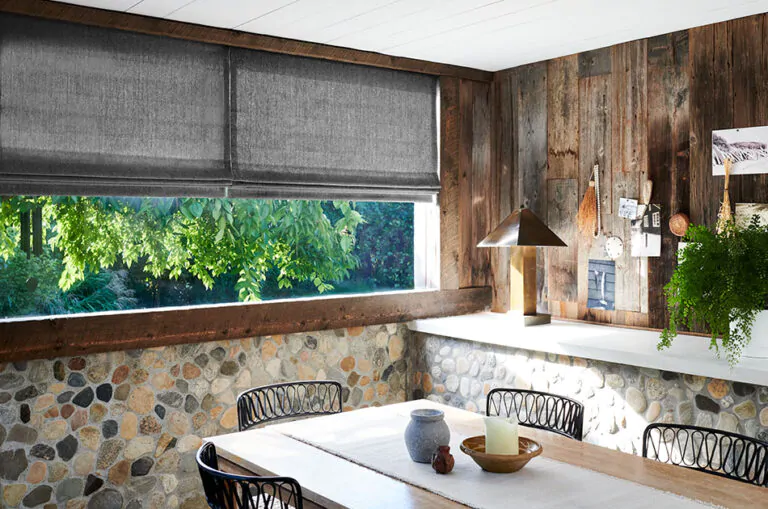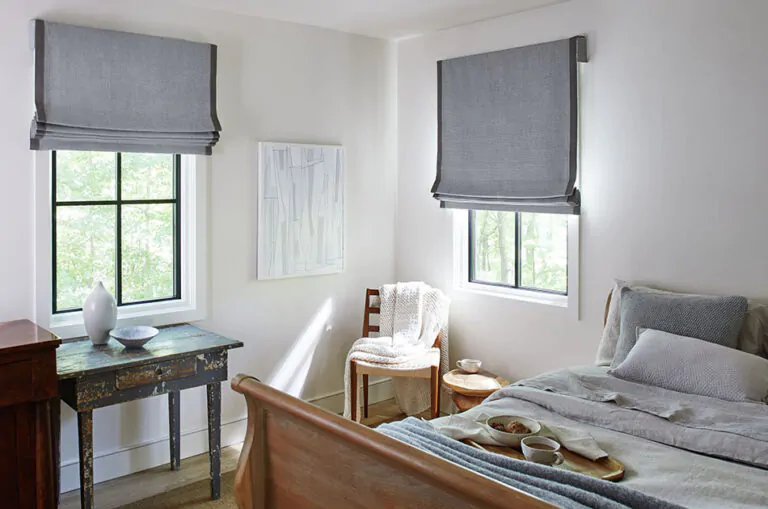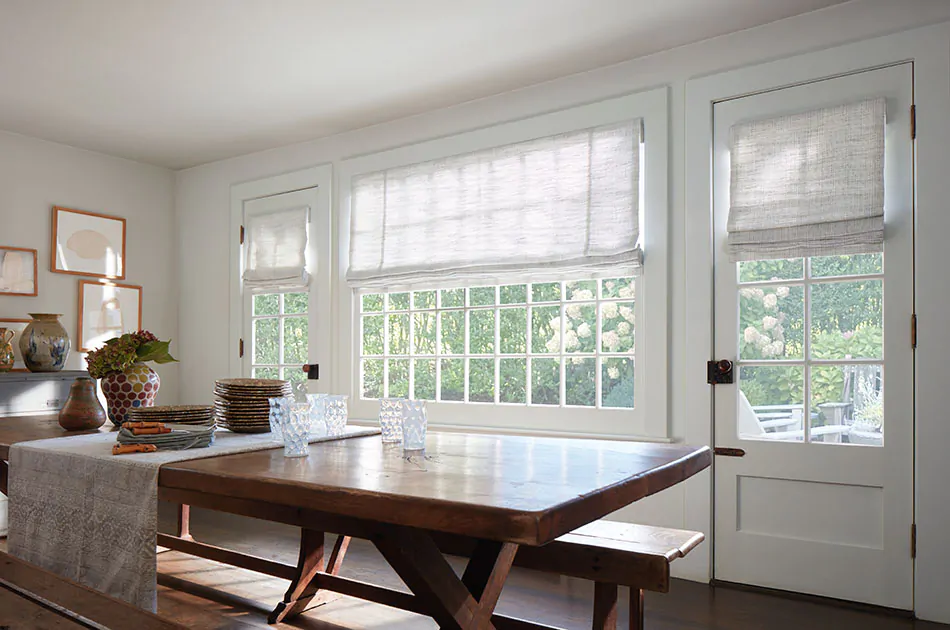
Your Door Window Shade Buying Guide
A door window shade is a great option for increasing your privacy and light control, especially at an entryway. Shades for doors with windows come in a wide variety of styles with different aesthetics and functionalities so you can find just the right one.
To choose the right door window shade for your space, learn all about shades for door windows, including what they are, benefits, product options, inspirational examples, measuring and install tips and more.
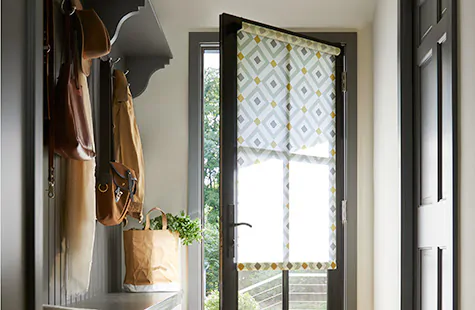
What Is a Door Window Shade?
Typically, a door window shade is a shade or set of blinds that covers the window on a door without obstructing the door’s ability to be opened and closed. This usually means the shade or set of blinds is installed on the door itself, just above the window.
A door window shade can sometimes be a larger shade installed above the door frame on the wall or ceiling. This application can be somewhat inconvenient for doors that swing open and close on hinges, as the shade or blinds will obstruct the door’s use whenever it is pulled down over the door. However, for windows on sliding doors, this is often the best application. The advice provided here primarily speaks to a door window shade installed on a door that swings open and closed on hinges, unless otherwise noted.
Overview: Door Window Shade Benefits
Choosing blinds or shades for doors with windows has several benefits, including:
- Improves light and privacy control at your entryway.
- Adds texture and dimension to your door and entryway.
- Maintains your door’s functionality whether the shade is raised or lowered when installed on your door.
What Is the Best Way to Cover a Door Window?
The best door window shade options are those that can be installed without interfering with your ability to use your door — whether the shade is raised or lowered. However, the perfect choice for your specific application will depend on unique factors to your applications such as your light and privacy needs as well as aesthetic preferences.
To help you pick the perfect door window shade, first explore your product options and then dive into important factors to consider to make the best decision.
Door Window Shade Options
Below are some of the best choices available that are most likely to give you light and privacy control without losing functionality of your door.
Where Drapery Fits In
Drapery is a beautiful window treatment choice and can also be used to cover a door window. However, the way drapery will function with your door is very different than the way shades and blinds will function. The only way to hang drapery over a door window without hindering your door’s functionality is to hang it high and wide beyond the door. This allows you to pull the drapery completely off your door whenever you need to use it. This means drapery does not provide coverage over your door window as long as you’re using your door. Shades and blinds, on the other hand, can be installed right on the door, so that they can be fully extended for light control and privacy without hindering your door’s functionality at all.
When it comes to drapery for door windows, they’re best applied as panels that cover sidelights on either side of your door. Or, you can use drapery on a door that is infrequently used, so you’re not constantly adjusting your curtains.
How to Choose the Best Door Window Shade
Now that you know what all the best options are for your door window shade, you’re ready to think through considerations for choosing the right one for your space.
Size Considerations
To order the correct size of door window shade or blinds, you can measure your door window just like you would for an outside mount window application. If installing your shade or blinds directly on the door, be sure to leave enough clearance between the window treatment and the inside edge of your door so you can open and close it without the material getting caught between the hinges. Additionally, you’ll want to measure your shades or blinds to ensure they don’t hit your door handle. This might mean making sure the window treatment is narrow enough to fit behind a lever handle or isn’t made too wide to run over your doorknob.
You can also choose to install your shades or blinds on the wall or ceiling above your door. In this case, you’ll want to make sure the window treatment hangs far enough off the wall to fall in front of the door handle without hitting it. However, keep in mind that this application will mean you’ll need to lift your blinds or shades above the door every time you want to use the door.
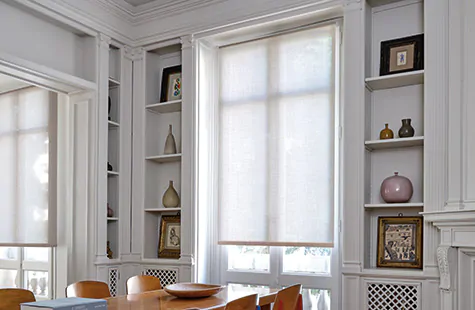
Light Control & Privacy Needs
Different types of window treatments give you different levels of light and privacy control. From light-filtering to blackout materials and linings, you can likely find the right amount of light and privacy control for your needs regardless of which type of door window shade you choose.
Energy Efficiency
If energy efficiency is a concern for your door window, whether it’s drafty or gets a lot of sun, some shades for doors with windows provide more insulation than others.
For sunny windows, your best bet is Solar Shades, which are made with unique material that blocks UV rays, the cause of heat buildup and interior fading, while still letting natural light filter into your home.
For drafty windows, the best choice is likely Cellular Shades, which will trap the cooler air in their cells and help keep your interior warmer.
Control Type
Control type refers to how you lift and lower your door window shade or blinds which will affect your everyday use. Finding the right option to suit your needs and the application is essential for choosing the best door window shade for your space.
The most common control types include:
- Continuous Loop – This control system features a looped chain held taut by a tension device. Simply pull the front side of the looped chain down to lift the shade and lift up on the chain to lower the shade. You can also pull down on the back side of the chain to lower the shade. Continuous loop is compatible with most types of shades, but not blinds.
- Cordless – Cordless control allows you to lift and lower your shade simply by pulling down or lifting up on the bottom rail or bar. For Roman and Woven Wood Shades, a ring will be sewn to the back of the shade that you’ll pull to adjust the height.
- Motorization – Motorization is by far the easiest control type as it allows you to adjust the height of your shades with the press of a button, through an app on your smartphone or tablet or with the sound of your voice when paired with a home automation system. Motorization is compatible with most types of shades and blinds. However, keep in mind that for blinds, motorization only allows you to adjust the tilt of the slats — you will not be able to lift or lower your blinds.
Style & Aesthetics
Aesthetics is an important factor for your door window shade selection as you’ll want the shade or blinds to match your home interior, while also looking attractive from the outside. Between the types of shades and blinds available, you have 1000+ materials to choose from, so you’re bound to find just the right look for your door window shade or blinds.
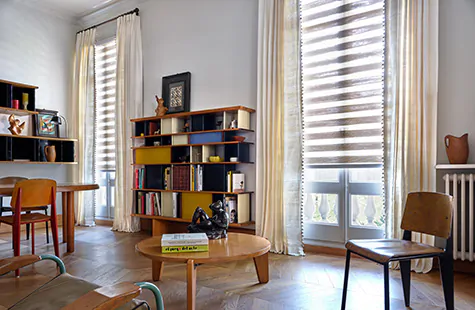
Explore Shades for Doors with Windows
Get inspired by these curated examples of shades for doors with windows, featuring several types of shades and blinds in different applications over a variety of door styles.
With an overview of all your options for a door window shade, as well as some ideas, you’re ready to think through measuring your window treatments for ordering as well as best practices for installation.
Measuring & Installation Best Practices
Measuring and installing blinds or shades for doors with windows are similar to measuring and installing these same window treatments on a window. You’ll follow the instructions for measuring and installing outside-mount shades or blinds if you’re fastening your window treatments to the door itself or the wall or ceiling above the door. If you’re installing the shade or blinds inside the door frame, you’ll follow the instructions for an inside-mount application.
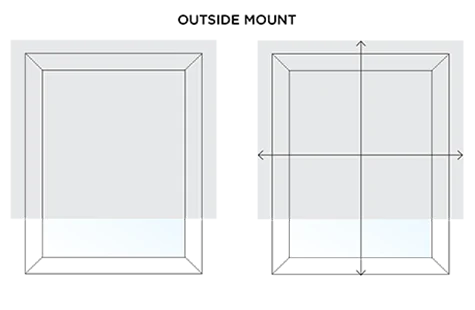
Measuring for Outside Mount
The process for measuring for an outside mount application where your shades or blinds are installed on the door or on the wall or ceiling above the door is a straightforward process. Plus, it’s universal, no matter the type of shade you have. Measure width based on how far you want your shade to extend on the door frame or beyond the door frame if it’s installed on the wall or ceiling above the door. Measure for length based on where the window treatment will sit: either on your door or above your door.
Measuring for Inside Mount
The process for measuring for an inside mount application, where the shade is installed inside your door frame, needs to be done so that it doesn’t interfere with the door’s functionality. Therefore, measure the depth from where the door hits when it’s closed to the edge of the door frame. You’ll also need to check the depth requirement of your chosen shade or blinds to ensure there’s enough space for a secure mount. Then, take three measurements each for length and width, using the largest number for ordering length and the smallest number for ordering width.
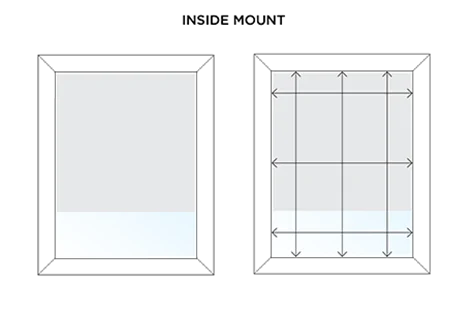
Prefer Professional Help?
When you choose a door window shade or set of blinds from The Shade Store, we offer free professional measurements to ensure the perfect fit and functionality.
Installation
The basic steps for installation of a door window shade or set of blinds includes:
- Step 1: Gather tools. You’ll typically need a stepladder, pencil, tape measure, level, drill and screwdriver, but check your blinds’ or shades’ specific install instructions for an exact list.
- Step 2: Decide whether you’ll inside or outside mount your blinds or shades, which means deciding whether to place them inside the window frame (inside-mount) or outside the window frame on the wall (outside-mount).
- Step 3: Measure appropriately based on your mount choice and mark where the mounting brackets and headboard, or tube, in the case of Roller and Solar Shades, will go.
- Step 4: Install the brackets in the right place with the appropriate tools as indicated in the installation guide for your chosen blinds and then attach the headrail or tube for Roller and Solar Shades.
Important
Always read the full installation instructions for your chosen shades or blinds before starting the install process. FIND INSTRUCTIONS
Find the Perfect Material for Your Door Window Shade
Now that you have an overview of your options and important considerations for choosing a door window shade, you have the foundation you need to start exploring material options. Not sure where to begin? Start with our Most Popular Swatch Collection which features beautiful neutral tones for many types of Shades and a few options for Blinds. And if you still want more options, you can order your favorite swatches a la carte for free.
